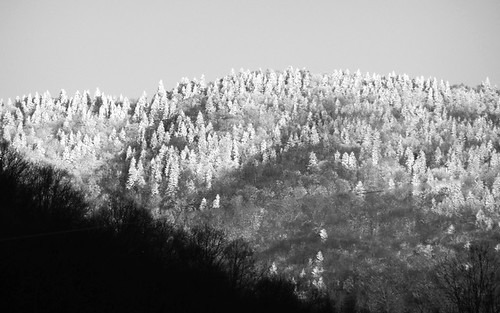Appreciate Trees this Holiday Season
By Gary Lovett, Senior Scientist and Forest Ecologist, Cary Institute of Ecosystem Studies, Millbrook, NY

The Fraser fir, Abies fraseri, an Appalachian native, is a popular Christmas tree. Though farms provide plenty of trees for the holiday season, the Fraser fir has nearly vanished in its native range under the ravages of a European insect, brought to the Americas through trade. Credit, Alex Wallace CC BY-NC-ND 2.0.
Tis the season when many Americans welcome trees into their homes. For millions of us, fresh-cut evergreens are at the heart of Christmas celebrations – a symbol of hope and joy. Sadly, the situation facing America’s trees is neither hopeful nor joyous.
The Fraser fir, one of the most popular Christmas trees, has seen its populations in the southeastern Appalachian Mountains dwindle to near extinction due to an imported insect called the balsam woolly adelgid. There is no shortage of Fraser firs on Christmas tree lots because plantations rely on costly insecticides. This is not an option for our parks and wild lands.
Hemlock trees, stalwarts of eastern old-growth forests, are also under attack. A tiny insect invader, no bigger than a speck of pepper, is literally sucking the life out of trees throughout the eastern U.S. Parts of the Smoky Mountains have lost 80% of their hemlocks due to infestations. Hemlocks play a vital role in shading creeks to create the coldwater pools that trout and fishermen love. When hemlock goes, so go the trout.
It’s not just our evergreens that are in trouble. Hundreds of millions of ash trees in cities and forests from the east coast to the Rockies have been lost to the emerald ash borer, an imported beetle. In Massachusetts, New York, and Ohio infestations of the exotic Asian longhorned beetle have resulted in costly quarantines and removal of hardwood trees.
The list of damaging imported forest pests is long and growing; each year they cause billions of dollars of damage to trees in our forests, yards, parks and cities. Yet the source of these tree-killing pests is well known—they enter the country via global trade, primarily as stowaways in wooden crates and pallets or as hitchhikers on live plants imported for landscaping.
Once released into our forests, imported pests are freed from their natural predators and encounter trees with little or no resistance. All too often, pest populations explode. The result can be near-extinction of our native trees, sometimes in as little as a few decades. We have seen this happen in the past with chestnut blight and Dutch elm disease, and the situation has intensified in recent years.
Fortunately, there are solutions. We should phase out solid wood packaging material in favor of manufactured wood-based products or other materials. This would not affect which goods are traded, only how they are shipped. We should restrict imports of live woody plants, to reduce the likelihood of spreading pests or diseases to native trees. This has the added advantage of bringing horticulture jobs back to the U.S. Finally, we should strengthen our surveillance and response at the national level, so new forest pest outbreaks are eradicated before they gain a foothold.
This holiday season, while appreciating the Christmas trees in our homes and cities, take a moment to reflect on the value trees bring to our lives. They give us lumber, fuel, and paper products. They shade our homes and clean our air. They provide wildlife habitat and protect our drinking water. They awe us with their magnificent size and beauty.
Come January 1, most cut Christmas trees will be on the curb. If you want to ensure the health of our trees and forests now and for future generations, make it your New Year’s Resolution to speak for the trees. Urge your legislators to adopt sensible Tree-SMART Trade strategies. You can learn more at: www.caryinstitute.org/tree-smart-trade.
